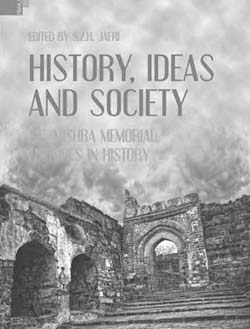Acompilation of ten essays originally presented on the occasion of the S.C. Mishra memorial at the Indian History Congress, History, Ideas and Society covers a wide variety of themes, ranging from historical ideas and ideologies to colonialism, communalism, sex-education, science and coins, the book portrays the dynamics of Indian history at its best. By bringing together writings on various periods of time and place, it not only adds to the richness but also contributes to unravelling the pathbreaking moments of Indian historical research. Jafri in his preface has written about the diversity of the articles claiming that there is ‘little to unify them’ except their loose ties in addressing ‘certain concerns and problems that have informed scholarly reflection among the historians of South Asia’ (p. vii). However what he forgets to mention and is yet amply evident in this wonderful compilation is the presence of different historical methodologies (subaltern history, regional history, postmodernism debates) and historical styles (narrative, biographical) too that would be a treat for historians any day.
The first essay, ‘Seductive Orientalism’, by Rajesh Kochhar revisits the ongoing caste and class debates in colonial India. It examines the role of British presence and their fostering of English education that went on to create an Indian stereotype connected to race and caste sentiments. He argues how this was seductive for a rising Indian social class who stood to gain from the British Raj. One cannot but agree with Kochhar here as he perfectly captures the paradox of the moment—the coexistence of ‘the conservative and the progressive elements’ manifested in the opportunities of social mobility available for certain castes and the simultaneous refixation and solidification of caste categories (p. 13). But where he stops with examples of Rammohan Roy or Mahendralal Sircar as the propagandists of reform within the castebased colonial framework, J.V. Naik takes up the case of ‘Mahatma Jyotirao Phule: Crusader for Social Justice’. Naik’s essay registers the changing mentalities of social reformists like Phule who denied being part of the high caste monopolized Brahmo Samajis. He strove instead for social justice through the uplift of the non-Brahmin lower classes. In both the examples however, the indelible mark of western ideological impact on the Indians educated in an English fashion can be strongly ascertained. In line with this, Naik’s second piece in this book on Maharshi Dhondo Keshav Karve and his son, Samaj swastyakar Raghunath Karve as the pioneers of birth control and sex-education movement in twentieth century colonial India is further proof of greater developments on the platform of social reforms. What is remarkable here is that it was not only the West, but also Asian nations like Japan that influenced the Kharves’ ideologies (p. 271). These biographical accounts besides capturing the social problems also provide a reflection of the changes in the political space and the reception of colonial ideas among the Indian intelligentsia at various points of time.
Complementary to it is the third essay of this volume on the ‘Cult of Rama Dasarath’ by Suvira Jaiswal which reveals the uses of history as a political tool. Pertinent to the controversies on RamjanmabhoomiBabri Masjid in Ayodhya, followed by the ASI reports and the dropping of A.K. Ramanujan’s paper, ‘Three Hundred Ramayanas: Five Examples and three Thoughts on Translation’ from the Delhi University syllabus, India has witnessed the emergence of a whole new discourse called ‘Ramology’. Jaiswal’s essay, in this light, elaborates on the construction of Rama Dasarathi within the Vaishnava tradition and the changes made to the character of Rama as a hero in order to suit the philosophy of every politico-religious group from the 10th to the 16th centuries. All the loose ends of caste, class and religion as enumerated in these above-mentioned essays have been tied together by Binay Bhushan Chaudhuri in his ‘Reinterpreting Santhal Insurgency, The Hool of 1855’.

